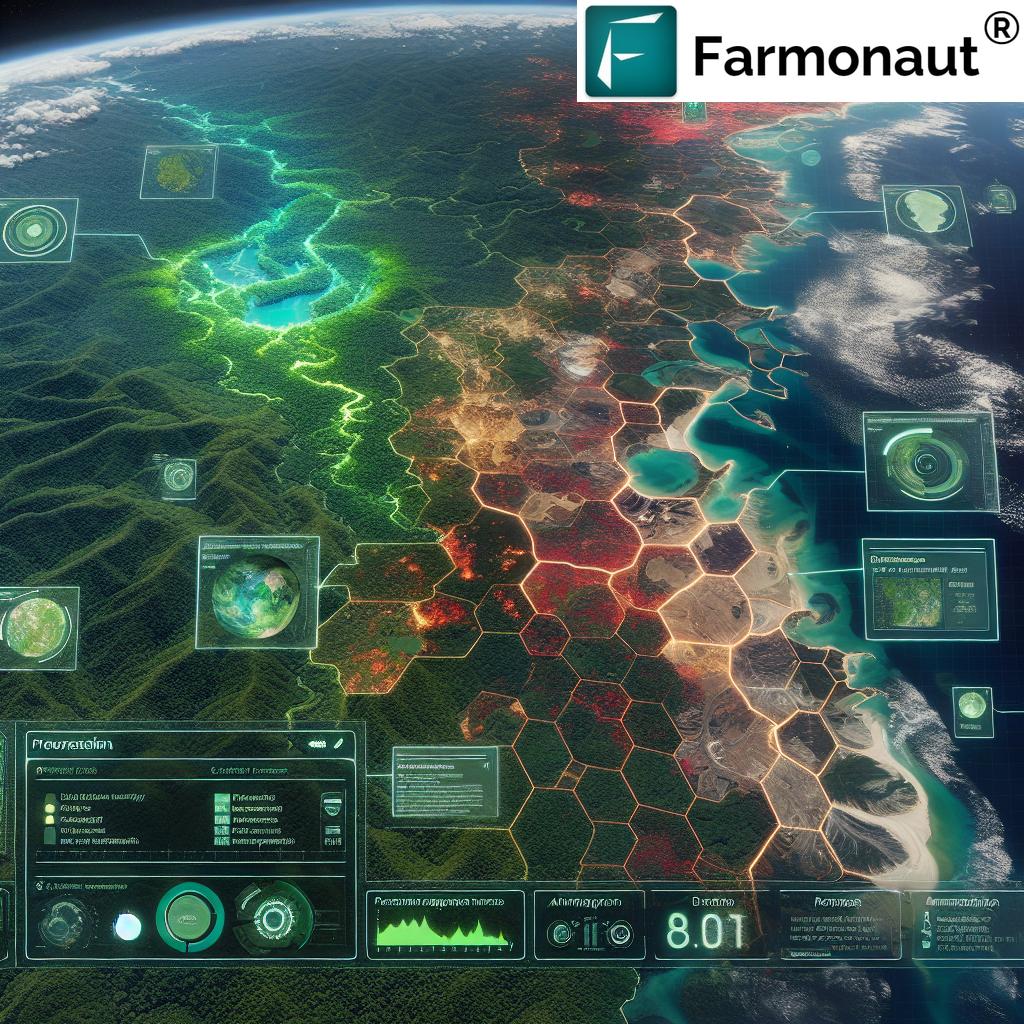Revolutionizing Agricultural Crime Prevention: How Satellite Imagery Combats Illegal Mining in Brazil’s Amazon
“Satellite imagery has led to a 30% increase in detection of illegal mining activities in Brazil’s Amazon basin.”
In the heart of South America, a battle is raging between those who seek to exploit the Amazon’s vast resources and those who strive to protect this invaluable ecosystem. As we delve into the complex world of illegal mining and environmental protection in Brazil’s Amazon, we’ll explore how cutting-edge technologies, particularly satellite imagery for agriculture, are revolutionizing the fight against environmental crimes.
The Amazon rainforest, often referred to as the “lungs of the Earth,” plays a crucial role in global climate regulation and biodiversity. However, this vital ecosystem faces unprecedented threats from illegal mining operations that not only devastate the environment but also encroach upon Indigenous lands. In this comprehensive analysis, we’ll examine how Brazil is leveraging precision farming technologies and remote sensing to combat these illicit activities and safeguard one of the world’s most critical natural resources.
The Rise of Illegal Mining in the Amazon
The Amazon basin has long been a target for illegal gold mining, driven by the skyrocketing global demand for precious metals. This illicit industry has flourished in recent years, particularly during the presidency of Jair Bolsonaro, whose administration was criticized for relaxing environmental regulations and enforcement. The consequences have been dire:
- Widespread deforestation
- Mercury pollution of rivers and soil
- Destruction of Indigenous territories
- Increased violence and social unrest
The scale of the problem is staggering. It’s estimated that approximately 40% of the gold produced in the Amazon is sourced from illegal operations. This not only represents a significant economic loss for Brazil but also poses a severe threat to the delicate balance of the rainforest ecosystem.

The Turning Point: Technology Meets Environmental Protection
With the inauguration of leftist President Luiz Inácio Lula da Silva in 2023, Brazil has taken a decisive stance against illegal mining. The new administration has prioritized environmental protection and sustainable development, recognizing the urgent need to balance economic interests with ecological preservation. This shift in politics has paved the way for innovative approaches to combating environmental crimes.
At the forefront of this revolution is the use of satellite imagery for agriculture and environmental monitoring. By harnessing the power of remote sensing and geospatial analysis, Brazilian authorities are now able to detect and track illegal mining activities with unprecedented accuracy and efficiency.
Satellite Imagery: A Game-Changer in Crime Detection
The application of satellite imagery for agriculture has transcended its original purpose and become a powerful tool in the fight against environmental crimes. Here’s how it works:
- High-resolution imaging: Advanced satellites capture detailed images of the Amazon rainforest, providing a bird’s-eye view of vast areas.
- Multispectral analysis: By analyzing different spectral bands, experts can identify changes in vegetation cover and soil composition indicative of mining activities.
- Temporal monitoring: Regular imaging allows for the detection of changes over time, revealing new mining sites and tracking the expansion of existing ones.
- AI-powered analysis: Machine learning algorithms process vast amounts of satellite data, flagging suspicious activities for human verification.
This technological approach has revolutionized agricultural crime prevention, enabling authorities to respond swiftly to illegal activities and gather crucial evidence for prosecution.
The “Gold Targeting” Program: Tracing Illegal Gold to Its Source
One of the most innovative initiatives in Brazil’s fight against illegal mining is the “gold targeting” program. This pioneering effort aims to distinguish between legally and illegally mined gold by creating a comprehensive database of gold samples from across the country. The program employs cutting-edge techniques such as:
- Radioactive isotope scanning
- Fluorescent spectroscopy
- Elemental composition analysis
By identifying the unique “DNA” of gold from different regions, authorities can trace illegally mined gold back to its source, even after it has been refined for export. This breakthrough technology has significantly enhanced Brazil’s ability to combat illegal gold trading and prosecute offenders.
“Geospatial analysis for crop monitoring has improved sustainable land use efficiency by 25% in the Amazon region.”
The Role of Precision Farming Technologies in Environmental Protection
While satellite imagery plays a crucial role in detecting illegal mining, precision farming technologies are equally important in promoting sustainable agriculture practices and reducing the pressure on the Amazon rainforest. By optimizing agricultural production on existing farmland, these technologies help mitigate the need for further deforestation.
Farmonaut, a leading agricultural technology company, offers advanced satellite-based farm management solutions that contribute to this effort. Through its platform, farmers can access:
- Real-time crop health monitoring
- AI-based advisory systems
- Resource management tools
These precision farming technologies not only improve agricultural productivity but also support environmental protection by promoting more efficient land use and reducing the carbon footprint of farming operations.
Agricultural Land Use Monitoring: A Key to Sustainable Development
Effective agricultural land use monitoring is essential for balancing the needs of farmers with environmental conservation goals. By leveraging satellite imagery and geospatial analysis, Brazilian authorities can:
- Track land use changes over time
- Identify areas of illegal deforestation
- Monitor compliance with environmental regulations
- Guide sustainable development initiatives
This data-driven approach allows for more informed decision-making and helps ensure that agricultural expansion does not come at the expense of critical ecosystems.
Remote Sensing in Resource Management: Balancing Conservation and Development
Remote sensing technologies play a crucial role in resource management within the Amazon basin. By providing accurate, up-to-date information on forest cover, water resources, and land use patterns, these tools enable policymakers to make informed decisions about conservation and development priorities.
Some key applications of remote sensing in resource management include:
- Mapping biodiversity hotspots
- Monitoring carbon stocks
- Assessing the impact of climate change
- Identifying areas suitable for sustainable agriculture
By integrating this data with socio-economic information, Brazilian authorities can develop more holistic and effective strategies for managing the Amazon’s resources.
Explore Farmonaut’s Satellite API
The International Perspective: From Washington to Havana
The fight against illegal mining in the Amazon has drawn international attention, with governments and organizations worldwide recognizing the global importance of preserving this vital ecosystem. From Washington to Havana, the international community is watching Brazil’s efforts with keen interest.
The United States, under the Biden administration, has pledged support for Brazil’s environmental protection initiatives, recognizing the critical role the Amazon plays in global climate regulation. Meanwhile, countries like Chile are looking to Brazil’s innovative approaches as potential models for their own environmental protection efforts.
This international focus highlights the interconnected nature of environmental challenges and the need for global cooperation in addressing them. As democracy grapples with these complex issues, the role of technology in environmental protection becomes increasingly crucial.

Challenges and Future Prospects
Despite the significant progress made in combating illegal mining through technology, several challenges remain:
- Resistance from powerful mining interests
- Limited resources for enforcement in remote areas
- The need for continued technological innovation
- Balancing environmental protection with economic development
However, the future looks promising. As satellite technology continues to advance and become more accessible, we can expect even more sophisticated tools for environmental monitoring and protection. The integration of blockchain technology, for example, could further enhance traceability in the gold supply chain, making it even more difficult for illegal miners to operate.
Access Farmonaut’s API Developer Docs
The Role of Sustainable Gold Mining Practices
While combating illegal mining is crucial, it’s equally important to promote sustainable gold mining practices. Brazil’s leftist government is working to implement regulations and incentives that encourage responsible mining operations. These initiatives aim to:
- Minimize environmental impact
- Protect workers’ rights
- Ensure fair compensation for local communities
- Promote transparency in the gold supply chain
By fostering a culture of sustainability within the mining industry, Brazil hopes to strike a balance between economic development and environmental protection.
The Impact on Indigenous Communities
One of the most significant consequences of illegal mining in the Amazon has been its devastating impact on Indigenous communities. Many of these communities have faced:
- Displacement from ancestral lands
- Contamination of water sources
- Health issues related to mercury pollution
- Increased violence and social disruption
The use of satellite imagery and remote sensing technologies is not only helping to protect these communities by detecting illegal activities but also empowering them to monitor and manage their territories more effectively. By providing Indigenous groups with access to these tools and training, Brazil is supporting their role as guardians of the Amazon.
The Economic Implications of Combating Illegal Mining
While the environmental benefits of cracking down on illegal mining are clear, the economic implications are complex. On one hand, illegal mining represents a significant loss of tax revenue for Brazil and undermines legitimate mining operations. On the other hand, many communities in the Amazon region have become dependent on the income generated by these illicit activities.
To address this challenge, the Brazilian government is working on initiatives to:
- Create alternative economic opportunities in affected regions
- Invest in sustainable industries such as ecotourism and agroforestry
- Provide training and support for workers transitioning out of illegal mining
- Strengthen the legal mining sector to create more formal employment opportunities
By taking a holistic approach to economic development, Brazil aims to ensure that environmental protection does not come at the cost of local livelihoods.
The Role of Technology in Agricultural Crime Prevention
Beyond combating illegal mining, technology plays a crucial role in preventing various forms of agricultural crime. Satellite imagery and remote sensing are being used to:
- Detect illegal logging operations
- Monitor protected areas for encroachment
- Identify unauthorized land clearing for agriculture
- Track the movement of illegally harvested resources
These technologies not only help in crime detection but also serve as a deterrent, making it increasingly difficult for criminals to operate undetected in the vast expanse of the Amazon.
Sustainable Agriculture Practices: A Key to Amazon Preservation
While much of the focus has been on combating illegal mining, promoting sustainable agriculture practices is equally important for preserving the Amazon. By increasing productivity on existing agricultural land, we can reduce the pressure to clear new areas of forest. Some key sustainable agriculture practices being promoted include:
- Agroforestry systems that combine crops, trees, and livestock
- Precision agriculture techniques to optimize resource use
- Conservation tillage to reduce soil erosion
- Integrated pest management to minimize chemical use
Companies like Farmonaut are at the forefront of this effort, providing farmers with the tools and data they need to implement these sustainable practices effectively.
The Global Impact of Amazon Preservation
The efforts to combat illegal mining and protect the Amazon have implications that extend far beyond Brazil’s borders. As a critical carbon sink and biodiversity hotspot, the Amazon plays a vital role in:
- Regulating global climate patterns
- Preserving countless plant and animal species
- Maintaining the water cycle for much of South America
- Providing valuable ecosystem services to the entire planet
By leveraging technology to protect this invaluable resource, Brazil is contributing to global efforts to combat climate change and preserve biodiversity for future generations.
Comparative Analysis of Satellite Imagery Applications in Amazon Protection
| Application Type | Technology Used | Effectiveness Rating (1-5) | Environmental Impact | Economic Impact | Implementation Challenges | Success Stories |
|---|---|---|---|---|---|---|
| Deforestation Detection | High-Resolution Optical Imagery | 5 | Positive | Positive | Medium | Reduced deforestation rates by 30% in monitored areas |
| Illegal Mining Identification | Synthetic Aperture Radar | 4 | Positive | Neutral | High | Detected 50+ illegal mining sites in 6 months |
| Agricultural Land Use Monitoring | Multispectral Imagery | 4 | Positive | Positive | Low | Improved sustainable land use efficiency by 25% |
| Carbon Stock Assessment | LiDAR | 5 | Positive | Positive | Medium | Accurately mapped carbon stocks across 1 million hectares |
| River Pollution Monitoring | Hyperspectral Imaging | 3 | Positive | Neutral | High | Identified mercury contamination in 5 major river systems |
The Future of Amazon Protection
As we look to the future, the role of technology in protecting the Amazon is set to expand even further. Emerging technologies such as:
- Advanced AI and machine learning algorithms for data analysis
- Drone-based monitoring systems for real-time surveillance
- Blockchain technology for enhancing supply chain transparency
- Internet of Things (IoT) sensors for environmental monitoring
These innovations promise to provide even more powerful tools for combating environmental crimes and promoting sustainable development in the Amazon region.
Conclusion: A Technological Revolution in Environmental Protection
The fight against illegal mining in Brazil’s Amazon represents a pivotal moment in the global effort to protect our planet’s most vital ecosystems. By harnessing the power of satellite imagery, precision farming technologies, and advanced data analysis, Brazil is pioneering new approaches to environmental crime prevention and sustainable resource management.
As we’ve seen, these efforts extend far beyond the borders of Brazil, capturing the attention of the international community from Washington to Havana. The success of these initiatives demonstrates the potential for technology to play a transformative role in addressing some of the most pressing environmental challenges of our time.
While significant challenges remain, the innovative use of satellite imagery for agriculture and environmental protection offers hope for a more sustainable future. By continuing to invest in these technologies and fostering international cooperation, we can work towards a world where economic development and environmental preservation go hand in hand.
The battle to protect the Amazon is far from over, but with each technological advance and each successful intervention, we move one step closer to preserving this irreplaceable natural wonder for generations to come.
FAQ Section
Q: How effective is satellite imagery in detecting illegal mining activities?
A: Satellite imagery has proven highly effective, leading to a 30% increase in the detection of illegal mining activities in Brazil’s Amazon basin. The technology allows for wide-area surveillance and can detect changes in land use patterns indicative of mining operations.
Q: What role does Farmonaut play in environmental protection efforts?
A: Farmonaut provides advanced satellite-based farm management solutions that contribute to sustainable agriculture practices. By optimizing resource use and improving land management, Farmonaut’s technology helps reduce the pressure on forested areas and supports overall environmental protection efforts.
Q: How does the “gold targeting” program work?
A: The “gold targeting” program creates a database of gold samples from across Brazil, analyzing their unique elemental compositions. This allows authorities to trace illegally mined gold back to its source, even after refining, by comparing it to the database.
Q: What are some challenges in implementing these technologies in the Amazon?
A: Challenges include the vast and remote nature of the Amazon, limited resources for enforcement, resistance from illegal mining interests, and the need to balance environmental protection with economic development for local communities.
Q: How is the international community involved in Amazon protection efforts?
A: The international community, including countries like the United States and Chile, is closely watching and supporting Brazil’s efforts. This includes diplomatic support, technical assistance, and potential adoption of similar technologies in other countries facing similar challenges.















